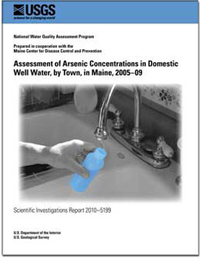Prior studies have established that approximately 10 percent of domestic wells in Maine have arsenic levels greater than the U.S. Environmental Protection Agency maximum contaminant limit (10 micrograms per liter (ug/L)). Of even greater concern are multiple discoveries of wells with very high arsenic levels (> 500 ug/L) in several areas of the State. A study was initiated to assist the Maine Center for Disease Control and Prevention (ME-CDC) in developing a better understanding of the statewide spatial occurrence of wells with elevated arsenic levels at the individual town level, identify areas of the State that should be targeted for increased efforts to promote well-water testing, and generate data for potential use in predicting areas of the State likely to have very high levels of arsenic. The State's Health and Environmental and Testing Laboratory (HETL) annually analyzes samples from thousands of domestic wells for arsenic. Results of arsenic analyses of domestic well water submitted to the HETL from 2005 to 2009 were screened and organized, by town, in order to summarize the results for all towns with samples submitted to the HETL. In order to preserve the privacy of well owners, the screening and organization of samples was conducted in the offices of the ME-CDC, following applicable Maine and United States laws, rules, and privacy policies. After screening, the database contained samples from 531 towns in Maine and from 11,111 individual wells. Of those towns, 385 had samples from 5 or more individual wells, 174 towns had samples from 20 or more individual wells, and 49 towns had samples from 60 or more wells. These samples, because they were submitted by homeowners and were not part of a random sample, may not be representative of all wells in a given area. The minimum, maximum, and median arsenic values for the towns with five or more samples were calculated, and the maximum and median values were mapped for the State. The percentages of samples exceeding 10, 50, 100, and 500 ug/L were calculated for the 174 towns with 20 or more sampled wells, and statewide maps were prepared for each of these categories. More than 25 percent of the sampled wells in 44 towns exceeded 10 ug/L. Many fewer towns had wells with samples that exceeded the 50, 100, or 500 ug/L categories. For 19 towns, more than 10 percent of the sampled wells had arsenic concentrations that exceeded 50 ug/L, and in 45 towns, 1 percent or more exceeded 100 ug/L. Of these, Surry in Hancock County had 120 wells tested, and 23 percent of those wells had arsenic concentrations that exceeded 100 ug/L, which is a much higher rate than for other towns. In only four towns (Danforth in Washington County, Surry and Blue Hill in Hancock County, and Woolwich in Sagadahoc County), 1 percent or more of the sampled wells had arsenic concentrations greater than 500 ug/L during 2005-09. The distribution of high arsenic concentrations in wells follows some geographic patterns, which are generally geologically controlled. There are clusters or belts of towns with high arsenic concentrations (> 50 ug/L), such as in southern coastal areas, the Kennebec County area, and towns along the central coastal part of Maine. In contrast, there are areas of the State with low arsenic concentrations, such as the northernmost towns, as well as towns in the western and west-central areas. There appear to be three distinct large-scale areas of high concentrations of arsenic in groundwater-one in southern coastal areas, one in central Kennebec County, and one in the town of Ellsworth (Hancock County) and the surrounding areas. In addition, several smaller clusters of isolated high concentrations of arsenic in groundwater exist. Earlier testing has identified other clusters of very high arsenic concentrations in groundwater in the towns of Northport, Buxton/Hollis, and Waldoboro, but those samples were collected before 2005 and did not factor in this analysis.


